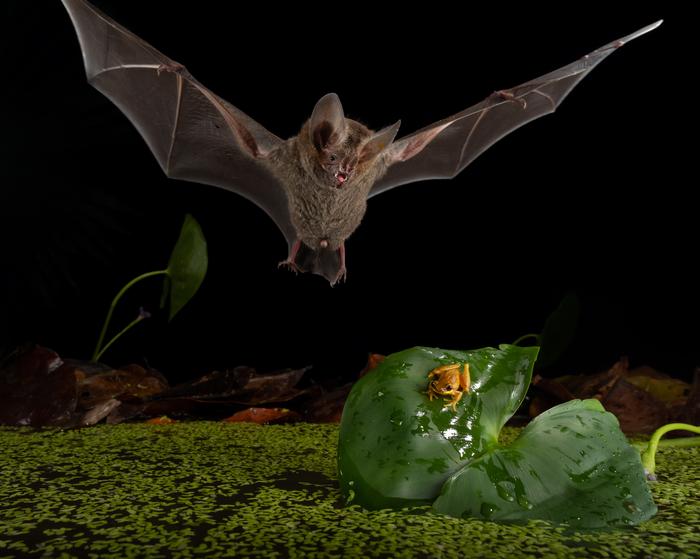High up in the humid darkness of Panama, a diminutive predator achieves what seems impossible. Relying on patience rather than haste, fringe-lipped bats save energy while capturing surprisingly sizable prey, as detailed in a new study from Aarhus University and the Smithsonian Tropical Research Institute published in Current Biology.
Equipped with small biologging backpacks that recorded sound and motion, researchers tracked 20 Trachops cirrhosus as they traversed the forests surrounding Soberanía National Park. The data unveiled a technique resembling that of large felines more than the standard bat behavior. Instead of incessantly chasing numerous insects in the air, these bats predominantly remained still throughout the night, often hanging out near ponds or perches, and then seizing the opportunity when it arose.
What makes this feat noteworthy is the underlying mathematics. Small predators typically have limited energy reserves and high metabolic rates during flight, leading to the common expectation of numerous small meals instead of a few substantial ones. However, the tagged bats were motionless for approximately 89 percent of their recorded duration. When they did take flight, the majority of flights lasted less than three minutes, with the median hunting flight lasting only eight seconds. Despite this minimal aerial exertion, their success rate hovered around 50 percent, surpassing that of lions at roughly 14 percent and significantly exceeding polar bears at nearly 2 percent.
The sensory tactic involves eavesdropping. Fringe-lipped bats are known for listening to frog mating calls, utilizing their low-frequency hearing to identify targets in the noisy forest environment. The tags indicated that they combine this passive listening with vision and echolocation, alternating between short flights inspired by loud frog choruses and quiet, ambush tactics to catch faint movements from larger prey. A notable moment from the data set showed chewing sounds persisting for 84 minutes after a catch, suggesting a meal nearly equal to the bat’s own weight.
Large Prey, Small Engine
On average, the prey weighed about seven percent of a bat’s 30-gram body mass, but the team recorded instances nearing equality, like Rosenberg’s gladiator tree frogs at nearly 20 grams. If you can envision it, picture a bat the size of a small plum hovering over a broad green leaf, then taking off with a frog almost as heavy as it is. The researchers even verified in controlled studies that such prey is manageable.
This research reframes a long-standing enigma. How do small predators fulfill their significant nightly energy requirements without expending excessive energy on lengthy hunts and unsuccessful pursuits? The answer, at least for this species, is to condense the hunting activity into brief but rewarding bursts, with rest intervals in between. This strategy, however, relies on undisturbed habitats where vertebrate prey in the one to 30-gram range are plentiful and near to roosting sites. The authors emphasize that the bats’ strategy thrives because the ecosystem remains intact.
“Rather than spending the whole night in flight, they remain patient, strike with precision, and occasionally catch massive, energy-rich prey.”
Lead author A. Leonie Baier, a Marie Skłodowska-Curie postdoctoral fellow at Aarhus University and research fellow at STRI, indicates that this behavior overturns previous assumptions. Essentially, these are large predators confined within small forms. Older bats also tended to capture larger prey more frequently, suggesting that experience enhances both their tactical approach and prey selection over years in the forest.
The Physics Of Patience
From an energy perspective, this method is sophisticated. Brief travels, short chases, and large meals balance the energy equation. Median flight durations were merely seconds, typical distances spanned tens of meters, and many attacks happened close to roosts. Nights evolved into a series of ambushes rather than a continuous flying marathon. Given the high energy cost of flapping, the savings accumulate quickly.
A word of caution is necessary. Should frog choruses diminish and small vertebrate populations decline, the bats would lose the acoustic signals and prey abundance that enable an effective high-gain ambush strategy. The study directly connects their notable efficiency to pristine ecosystems. Amidst a time of amphibian declines and fragmented forests, this reliance becomes a vulnerability rather than a luxury.
“With the data from our biologging tags, which integrate high-quality sound recordings with movement data, we could recreate entire hunting sequences in the wild.”
Senior author Laura Stidsholt describes an auditory glimpse into the night, creating a vibrant picture: quick bursts of wingbeats, a gentle landing on a leaf, followed by the steady rhythm of chewing. The statistics support the auditory observations. Over multiple half-nights of recording, bats made only a few attempts yet still fulfilled their estimated daily energy needs. This is not mere chance; it reflects a well-honed strategy.
Predators are often perceived merely based on their physical attributes and speed. This paper advocates for a different perspective, one that prioritizes information, timing, and restraint. Ultimately, the smallest hunters can behave like the largest, not through sheer force.
